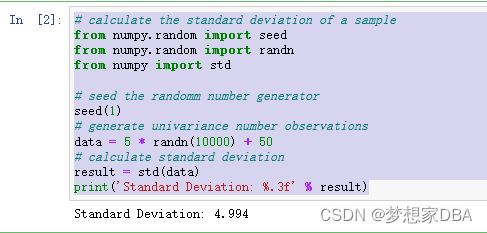1.Gaussian Distribution
2.Sample vs Population
3. Test Dataset
4. Central Tendencies
5.Variance
6.Describing a Gaussian
1.2 Gaussian Distribution
Let’s look at a normal distribution. Below is some code to generate and plot an idealized Gaussian distribution.
# generation and plot an idealized gaussian
from numpy import arange
from matplotlib import pyplot
from scipy.stats import norm
# x-axis for the plot
x_axis = arange(-3, 3, 0.001)
# y-axis as the gaussian
y_axis = norm.pdf(x_axis,0,1)
# plot data
pyplot.plot(x_axis, y_axis)
pyplot.show()
1.3 Sample vs Population
The data that we collect is called a data sample, whereas all possible data that could be collected is called the population.
- Data Sample : A subset of observations from a group
- Data Population : All possible observations from a group.
Two examples of data samples that you will encounter in machine learning include:
- The train and test datasets.
- The performance scores for a model.
When using statistical methods, we often want to make claims about the population using only observations in the sample. Two clear examples of this include:
- The training sample must be representative of the population of observations so that we can fit a useful model.
- The test sample must be representative of the population of observations so that we can develop an unbiased evaluation of the model skill.
1.4 Test Dataset
Before we explore some important summary statistics for data with a Gaussian distribution.We can use the randn() NumPy function to generate a sample of random numbers drawn from a Gaussian distribution.
We can then plot the dataset using a histogram and look for the expected shape of the plotted data. The complete example is listed below.
# generate a sample of random gaussians
from numpy.random import seed
from numpy.random import randn
from matplotlib import pyplot
# seed the random number generator
seed(1)
# generate univariate observations
data = 5 * randn(10000) + 50
# histogram of generated data
pyplot.hist(data)
pyplot.show()
Example of calculating and plotting the sample of Gaussian random numbers with more bins.
# generate a sample of random gaussians
from numpy.random import seed
from numpy.random import randn
from matplotlib import pyplot
# seed the random number generator
seed(1)
# generate univariate observations
data = 5 * randn(10000) + 50
# histogram of generated data
pyplot.hist(data, bins=100)
pyplot.show()1.5 Central Tendency
The central tendency of a distribution refers to the middle or typical value in the distribution. The most common or most likely value.In the Gaussian distribution, the central tendency is called the mean, or more formally, the arithmetic mean, and is one of the two main parameters that defines any Gaussian distribution.

The example below demonstrates this on the test dataset developed in the previous section.
# calculate the mean of a sample
from numpy.random import seed
from numpy.random import randn
from numpy import mean
# seed the random number generator
seed(1)
# generate univariate observations
data = 5 * randn(10000) + 50
# calculate mean
result = mean(data)
print('Mean: %.3f' % result)
The median is calculated by first sorting all data and then locating the middle value in the sample.
The example below demonstrates this on the test dataset.
# calculate the median of a sample
from numpy.random import seed
from numpy.random import randn
from numpy import median
# seed the random number generator
seed(1)
# generate univariate observations
data = 5 * randn(10000) + 50
# calculate median
result = median(data)
print('Median: %.3f' % result)
1.6 Variance
The variance of a distribution refers to how much on average that observations vary or differ from the mean value. It is useful to think of the variance as a measure of the spread of a distribution. A low variance will have values grouped around the mean.
The complete example is listed below.
# generate and plot gaussians with different variance
from numpy import arange
from matplotlib import pyplot
from scipy.stats import norm
# x-axis for the plot
x_axis = arange(-3, 3, 0.001)
# plot low variance
pyplot.plot(x_axis, norm.pdf(x_axis,0,0.5))
# plot high variance
pyplot.plot(x_axis,norm.pdf(x_axis,0,1))
pyplot.show()Running the example plots two idealized Gaussian distributions: the blue with a low variance grouped around the mean and the orange with a higher variance with more spread.

The variance of a data sample drawn from a Gaussian distribution is calculated as the average squared difference of each observation in the sample from the sample mean:

The example below demonstrates calculating variance on the test problem.
# calculate the variance of a sample
from numpy.random import seed
from numpy.random import randn
from numpy import var
# seed the random number generator
seed(1)
# generate univariate observations
data = 5 * randn(10000) + 50
# calculate variance
result = var(data)
print('Variance: %.3f' % result)
Where the standard deviation is often written as s or as the Greek lowercase letter sigma (σ). The standard deviation can be calculated directly in NumPy for an array via the std() function. The example below demonstrates the calculation of the standard deviation on the test problem.
# calculate the standard deviation of a sample
from numpy.random import seed
from numpy.random import randn
from numpy import std
# seed the randomm number generator
seed(1)
# generate univariance number observations
data = 5 * randn(10000) + 50
# calculate standard deviation
result = std(data)
print('Standard Deviation: %.3f' % result)Running the example calculates and prints the standard deviation of the sample. The value matches the square root of the variance and is very close to 5.0, the value specified in the definition of the problem.























 437
437











 被折叠的 条评论
为什么被折叠?
被折叠的 条评论
为什么被折叠?








